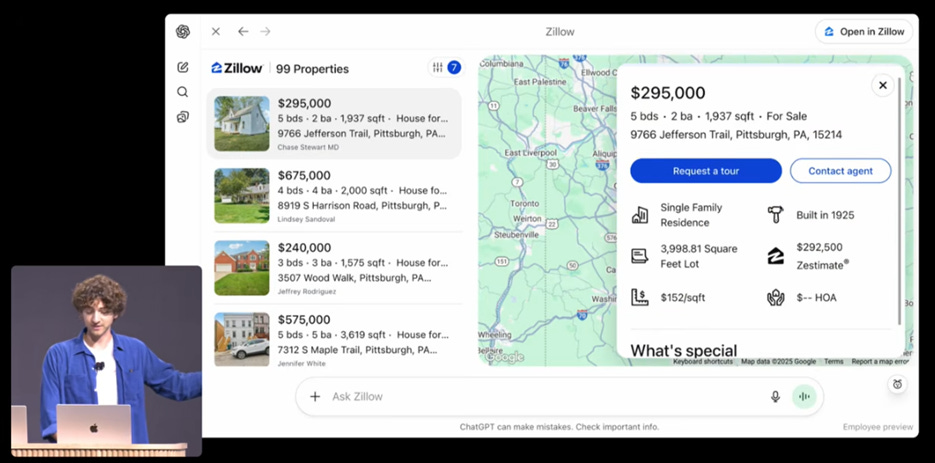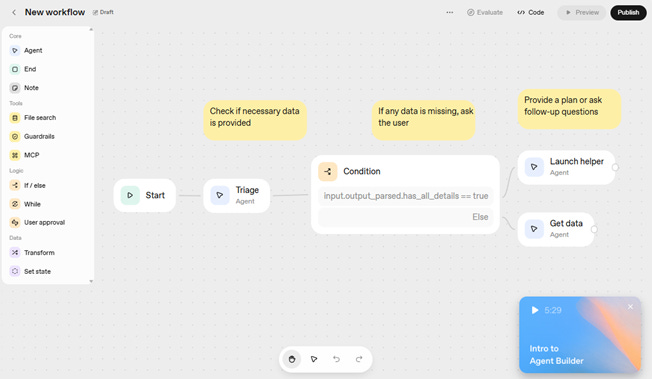OpenAI Dev Day
OpenAI announced new features for developers and users: Apps for ChatGPT, Apps SDK, AgentKit with ChatKit and AgentBuilder, improved Codex, Sora 2 in the API, and new gpt-realtime-mini.

Introduction
OpenAI had their annual Dev Day for 2025 on October 6th. This is OpenAI’s conference for developers, where they communicate to developers and partners working in the OpenAI ecosystem to build AI tools.
The OpenAI keynote highlighted three main product updates plus some new AI model updates:
Writing Code with Codex.
New AI model updates.
CEO Sam Altman presented the overview while other OpenAI employees shared demos of some of the new features.
Apps in ChatGPT and Apps SDK
We are making apps discoverable in the conversation. When a user asks for a playlist, ChatGPT can present Spotify. - OpenAI
Apps in ChatGPT is a feature that gives ChatGPT users seamless access to tools. In this feature, users can access applications using ChatGPT as the interface. Users can directly invoke an app by calling it out, or alternatively, ChatGPT can surface an appropriate app and needed context based on the prompt.
In a demo of this feature, they gave an example of presenting a Coursera video inside ChatGPT then pausing it and asking ChatGPT questions about it, using the video as context. They call this integration “talking to apps.”
They also gave an example of using Canva to make a pitch deck from the ChatGPT interface. Then they showed how ChatGPT can link to Zillow to find houses for sale in Pittsburg. With Zillow embedded in ChatGPT, Zillow presented a map and list view of homes. Then users can ask further questions of ChatGPT about selected homes, using other tools such as search and maps.
Is this experience any better than going directly to the application or website? It can be. The integration of tools with ChatGPT allows users to use the app as context to get information and to weave multiple tools together to process workflows.
In addition, OpenAI announced Apps SDK, an open standard built on MCP for integrating other apps within ChatGPT. Currently, there are ways to connect MCPs within AI agent tools, but this creates a more seamless connection within the OpenAI ecosystem. They support monetization features via OpenAI’s recently announced Agentic Commerce Protocol.
OpenAI announced partners on apps in ChatGPT: Booking.com, Canva, Coursera, Figma, Expedia, Spotify and Zillow. They will roll out more apps from more partners, and they will also release a directory. They seem to be aiming for an ecosystem similar to how the Apple app store works.
Building Agents with AgentKit: AgentBuilder, ChatKit, and Eval
Open introduced AgentKit as “everything you need to build, deploy and optimize agentic workflows, with way less friction.” AgentKit is a set of features and tools designed to take agents from prototype to production, consisting of three main components:
AgentBuilder, a drag-and-drop interface to build agent flows, based on responses API.
ChatKit, a tool to build chat interfaces, so developers can bring a ChatGPT-like interface to their own AI applications. It includes UI widgets, customizable prompts, and tool and file integration support.
Evals, which are support tools for evaluations of AI agents. This includes trace scanning, datasets, and automated prompt optimization.
AgentBuilder is a no-code graphical tool approach for agent building; it presents a visual canvas for drag-and-drop creation of AI agent workflows.
OpenAI gave a demo of the visual workflow AgentBuilder tool building an AI agent workflow. In a 7 minute demo, the Agent workflow was visually designed, previewed, and then put into production by publishing it. They very neatly showed off how easy it is to build and deploy simple AI agent flows.
AgentBuilder is available at https://platform.openai.com/agent-builder/. OpenAI subscribers can try it out for free; the costs accrue when you publish and run the agent.
OpenAI’s AgentBuilder is hardly novel. Microsoft CoPilot Studio, n8n, and others have similar no-code agent builders, and OpenAI has tried other forms of no-code customization (remember custom GPTs).
Is it a Zapier or n8n killer? Not necessarily. AgentBuilder is tied into the OpenAI ecosystem, which is both a strength in feature support (and locking people into their ecosystem) and a limitation.
The AgentBuilder takeaway is that it’s easier than ever to build AI agents. However, no-code custom agents tend to have limits in customization; many production custom AI agents will probably still require coding. OpenAI already has agent developers covered there, with AgentsSDK.
ChatKit is a way for developers to build a customized chat interface experience into an AI application. It can used in a way where OpenAI hosts the backend, or where the developer runs ChatKit on their own infrastructure.

Writing Abundant Software: Codex
OpenAI announced that Codex is out of preview and is in General Availability. They did not have any other major announcement, but pointed to three new features:
Slack integration, bringing Codex to work with Slack.
Codex SDK, which embeds the Codex agent that powers the Codex CLI into custom workflows, tools, and apps.
Enterprise controls, including monitoring and an analytics dashboard.
The real story of Codex and GPT-5 for coding is that OpenAI was runner-up to Anthropic’s Claude for most AI coding agent users, until GPT-5 and Codex improvements got OpenAI to match Claude Code.
Codex has had a big jump in capabilities now that it is powered by the GPT-5-Codex model.
OpenAI mentioned the GPT-5-Codex upgrade, claimed Codex has gotten better at code reviews, and stated OpenAI engineers complete 70% more pull requests each week with Codex. They shared usage increases, with Codex usage up 10-fold since early August, as social proof confirming Codex has improved. Users are liking the improved Codex.
OpenAI’s message was that they will continue to make Codex better over time. They are serious about competing in this space.
Software used to take months to build, now it can take minutes. – Sam Altman
Model Updates
OpenAI announced several AI model updates, bringing GPT-5 Pro, Sora 2, gpt-realtime-mini and gpt-image1-mini into their API.
GPT-5 Pro is now available in the API. It’s their best AI model, with higher intelligence and better instruction following than anything else OpenAI has released. It’s expensive, with $15 per million token input, and $120 per million token output, and it can also be slow:
“Since GPT-5 pro is designed to tackle tough problems, some requests may take several minutes to finish.”
A smaller high-quality voice model gpt-realtime-mini was released. This has the same voice quality and expressiveness of gpt-realtime but is 70% cheaper.
Similarly, gpt-image-1-mini is available in the API. This is a cost-efficient version of GPT Image 1, the natively multimodal language model with text and image input that can generate image outputs, with both image generation and editing. Generating a 1536x1024 resolution medium-quality image costs 1.5 cents per image, a quarter what equivalent generation in gpt-image-1 costs.
Their latest and greatest AI audio-video generation model Sora 2 is available in the API. Interface users have control over video length, aspect ratio, and remix video. They showed a Sora 2 clip where their partner Mattel was using Sora 2 for creative product development.
Conclusion
OpenAI is aggressively working as an AI product company to fill out a whole suite of AI framework applications. While DevDay is focused on developers, these announcements have major implications for OpenAI consumers as well.
The wider and deeper level of integration between ChatGPT and embedded apps changes the whole ChatGPT experience. It will become more like a browser, with on-demand information, and more agentic, able to do small tasks. ChatGPT is growing beyond its chatbot roots; it’s not just for chat anymore.
The no-code AgentBuilder is focused on end-users more than developers. Consider a business wants to DIY an AI agent instead of paying an AI agency.
This is not the first time OpenAI has tried integrations, but now they are basing their integrations on the MCP standard and their responses API. This standardized path is more likely to succeed, but it’s not a unique offering.
Similarly, Codex has gotten increasingly better with GPT-5 and a better Codex CLI. Yet it’s still a me-too product to Claude Code.
OpenAI has massive ambitions to be more than an AI model producer but also the leading developer of AI products and AI applications. OpenAI aims to become the Apple of AI: The top brand, with a vertically integrated AI technology stack, providing premium AI products for both consumers and businesses.
They are on track to succeed. OpenAI claims they are running 6 billion tokens per minute. That is 8.6 trillion tokens per day, or 3.15 quadrillion tokens per year. Assuming $4 per million tokens , this would generate about $34.6 million per day, or total revenue of about $12.6 billion per year. These estimates align with public estimates showing OpenAI’s huge revenue growth this year.



